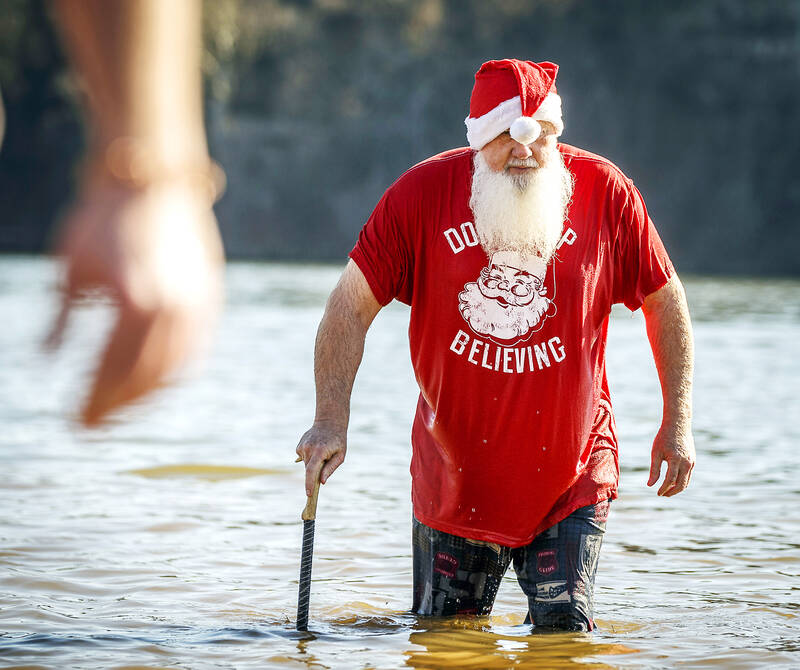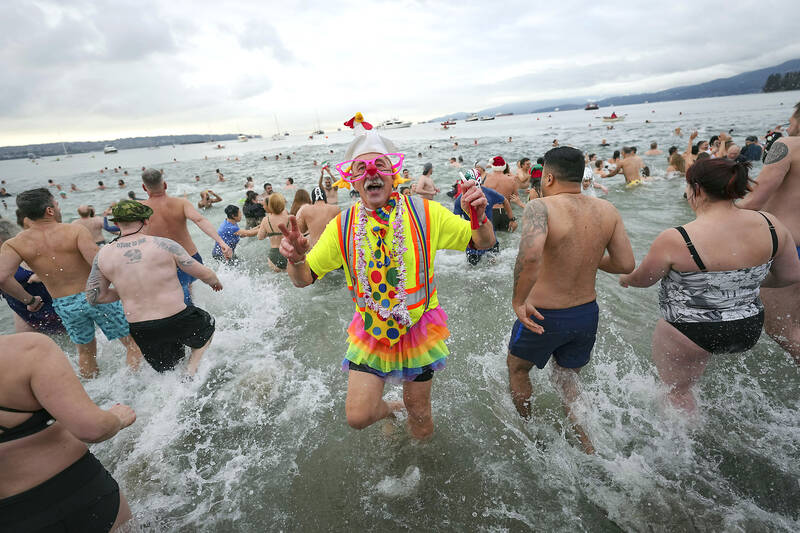Not so long ago, a cold plunge bath was used as a punishment for people considered insane. Now ice baths are feted by celebrities and social media influencers as a way to treat depression, lose weight and boost immunity. Yet immersion in cold water should be more widely recognized as a potentially lethal activity, according to academics, charities and even advocates of cold plunges.
“If this was people going for a gentle stroll, it would be fine,” said Mike Tipton, who has researched cold water immersion for four decades. “Sixty per cent of deaths in cold water happen in the first minute of immersion. You’re taking a tropical animal and dropping it into 12 degree Celsius water — that’s not a risk-free activity.”
Last week, a coroner ruled that Kellie Poole died from an undiagnosed heart condition triggered by a cold water immersion therapy session in the River Goyt in Whaley Bridge, Derbyshire, in April last year. The 39-year-old developed a sudden cardiac arrhythmia after entering the water, which was 10.7 degrees Celsius. She complained of a headache then fell forward and later died.

Photo: AP
Poole’s mother and Kevin O’Neill, who was leading the session, both said people offering cold water immersion as therapy should now be regulated. While the company running the session was not to blame for Poole’s death and could not have foreseen her adverse reaction, Peter Nieto, senior coroner for Derby and Derbyshire agreed, saying he would issue a prevention of future deaths report. The Department of Health and Social Care said it had no plans to regulate the activity.
The American Heart Association has warned against cold therapy, and the British Heart Foundation (BHF) said people with heart conditions should check with medical professionals before such treatments.
Jo Whitmore, senior cardiac nurse at the BHF, said those with heart conditions are safest in water between 26 degrees Celsius and 33 degrees Celsius.

Photo: AP
“Entering very cold water can lead to a shock which can cause a faster heart rate, higher blood pressure and shortness of breath.”
This, she added, could “lead to hypothermia and raise our stress hormone levels, increasing the risk of abnormal heart rhythms and possibly even cardiac arrest.”
From Hippocrates in Ancient Greece to Charles Darwin via Thomas Jefferson and Florence Nightingale, experts have advocated a cold plunge.
“The Romans had the frigidarium alongside all the hot baths they had,” said Tipton.
Yet it has also been used as punishment. In the 19th century, it was used on those held in Ireland’s Limerick asylum, and the practice was outlawed after a man known as Danford died there in 1873 following “submersion in a cold plunge bath.”
Wim Hof, the Dutch motivational speaker and self-styled Iceman, picked up the baton for cold water immersion, and Lewis Pugh completed an endurance swim across the north pole in 2007. Further stories of elite athletes such as Andy Murray and Jessica Ennis-Hill using ice baths added extra credibility.
The current trend emerged during the COVID lockdowns, Tipton said, adding that an open-water swimming group in Perranporth in Cornwall “went from 25 members to 1,000 over the course of the lockdown period.”
Fans tell of depression lifted, immune systems boosted and feeling more awake and alive. With celebrities including Madonna and Holly Willoughby seen in ice baths, the trend is now so mainstream that TikTok’s lists #coldplunge as having 1.5 billion views, while consumer news Web sites rank the best cold plunge tubs of this year, from £100 barrels to £13,000 plunge pools for the back garden — like a jacuzzi, but with an ice-maker.
Some organizations do highlight the risks. On Sunday, Surfers Against Sewage begins its Dip A Day in October campaign to raise money to protect the oceans, but they also publish prominent safety guidance.
The Outdoor Swimming Society, founded by journalist and author Kate Rew to promote swimming in rivers, lakes, lidos and seas, has published guides and warnings on its Web site.
“Some people feel really high when they get into cold water,” she said. “I’ve had people describe it as like the high they used to get from clubbing, or the second hour in a marathon. Then the vast majority of people just find it cold, unpleasant and draining. We just don’t hear about these people very often.”
Rew, to her surprise, is a recent convert after a trip to Finland involved a quick dip in a frozen lake followed by a sauna. Now she has a cold metal bath in her back garden.
“It’s the first thing I do when I wake up — skinny dipping in a tub,” said Rew, author of The Outdoor Swimmers’ Handbook. I check in with the sky and the weather, the wind in the trees, and I have this moment in a day which is a really focused joy. I don’t think I have the physiological thing that some people have that makes them addicted to cold. I like it just as a moment to breathe. And I do quite like being tough enough.
There’s little scientific evidence to support the wellbeing benefits of cold water, she says. There’s a dominant narrative that it’s very good for you to the extent that everyone should adopt it. But it’s not scientifically based. There isn’t much research except a lot of anecdotal evidence.
“So people should be liberated to follow their own inclinations,” she says.
Tipton has reviewed scientific literature about cold water immersion and said there are hypotheses for some of the claimed effects — cold shock triggers the release of stress hormones, which make people feel alert. There are hypotheses that immersion might reduce inflammation, the way the body protects itself from infection, and people who do cold water therapies say they have fewer colds.
“But they’re only hypotheses — there’s been no properly randomized controlled trials,” Tipton said. Trials could isolate the effects of cold water from other things: exercise, floatation, overcoming a challenge or being outdoors.
“I would not do anything that was seriously stressful without having a check-up that I was fit and healthy enough to do it,” said Tipton. “But it’s also how you go about it — the longer you spend in it, the greater the risk. It’s our estimation that if there are any benefits, they’re all accrued within a couple of minutes.”

In the March 9 edition of the Taipei Times a piece by Ninon Godefroy ran with the headine “The quiet, gentle rhythm of Taiwan.” It started with the line “Taiwan is a small, humble place. There is no Eiffel Tower, no pyramids — no singular attraction that draws the world’s attention.” I laughed out loud at that. This was out of no disrespect for the author or the piece, which made some interesting analogies and good points about how both Din Tai Fung’s and Taiwan Semiconductor Manufacturing Co’s (TSMC, 台積電) meticulous attention to detail and quality are not quite up to

April 21 to April 27 Hsieh Er’s (謝娥) political fortunes were rising fast after she got out of jail and joined the Chinese Nationalist Party (KMT) in December 1945. Not only did she hold key positions in various committees, she was elected the only woman on the Taipei City Council and headed to Nanjing in 1946 as the sole Taiwanese female representative to the National Constituent Assembly. With the support of first lady Soong May-ling (宋美齡), she started the Taipei Women’s Association and Taiwan Provincial Women’s Association, where she

It is one of the more remarkable facts of Taiwan history that it was never occupied or claimed by any of the numerous kingdoms of southern China — Han or otherwise — that lay just across the water from it. None of their brilliant ministers ever discovered that Taiwan was a “core interest” of the state whose annexation was “inevitable.” As Paul Kua notes in an excellent monograph laying out how the Portuguese gave Taiwan the name “Formosa,” the first Europeans to express an interest in occupying Taiwan were the Spanish. Tonio Andrade in his seminal work, How Taiwan Became Chinese,

Mongolian influencer Anudari Daarya looks effortlessly glamorous and carefree in her social media posts — but the classically trained pianist’s road to acceptance as a transgender artist has been anything but easy. She is one of a growing number of Mongolian LGBTQ youth challenging stereotypes and fighting for acceptance through media representation in the socially conservative country. LGBTQ Mongolians often hide their identities from their employers and colleagues for fear of discrimination, with a survey by the non-profit LGBT Centre Mongolia showing that only 20 percent of people felt comfortable coming out at work. Daarya, 25, said she has faced discrimination since she